Connecting You to Museum Professionals!
Have you ever made an observation and wanted to know more? Curious minds across New Brunswick have been sending their questions to the experts in our departments. We invite you to follow our “Ask an Expert” blog, where each month our staff will share their firsthand knowledge about all things New Brunswick!
Send a message to us on Facebook (@nbmmnb) or by email info@nbm-mnb.ca and watch for a response to your question on our social media channels!
Like the content featured on our blog and have your own pictures to share??? Share them with us by uploading your photos to social media! Don’t forget to tag us in your post @nbmmnb and use our hashtag #nbmmnb.
_______________________________________________________________________________
We’re answering your questions about all things New Brunswick with our Ask an Expert blog!
#AskAConservatorDay #AskAConservator
Today 4 November, 2021, the NBM participated in #AskAConservator day. This day commemorates the tragic flooding that damaged priceless cultural heritage in Florence on November 4th, 1966. In honour of the incredible efforts that were made to conserve the items impacted by the flood, this event is to celebrate the spirit of international collaboration and exchange of knowledge. ( Canadian Conservation Institute)
Q: What has been your favourite object to conserve?
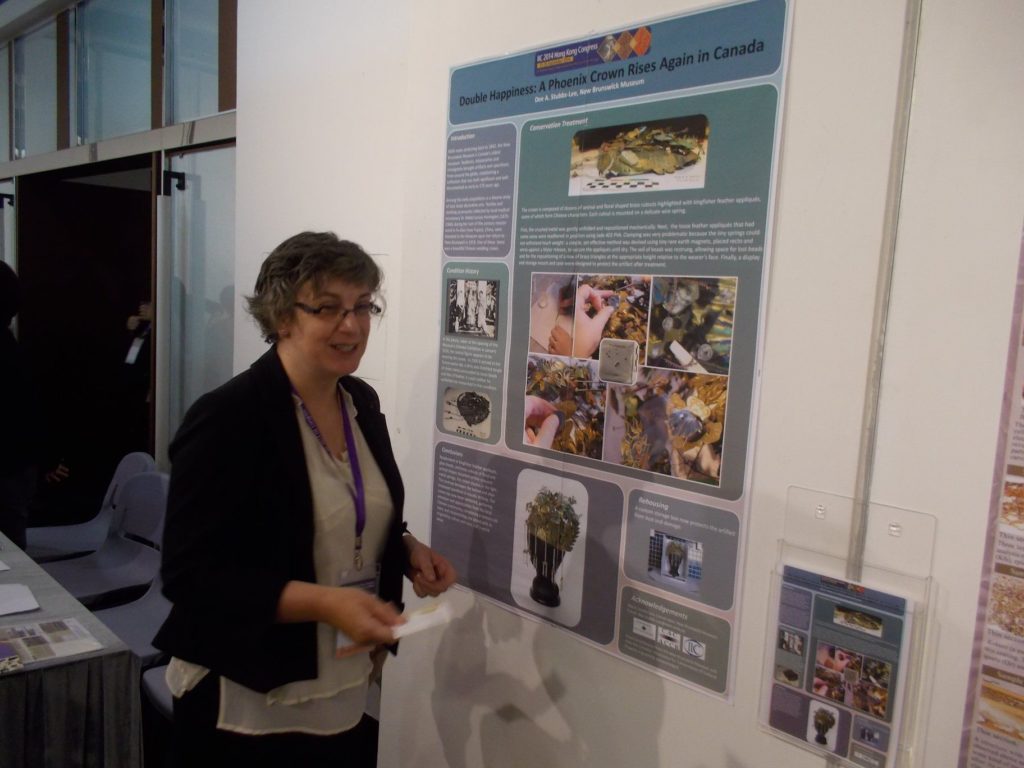
Dee Stubbs-Lee, NBM Conservator presents a poster on the topic of her conservation treatment of the New Brunswick Museum’s Chinese bridal crown, entitled “Double Happiness: A Phoenix (Crown) Rises Again in Canada” at the IIC Congress held in Hong Kong in 2014.
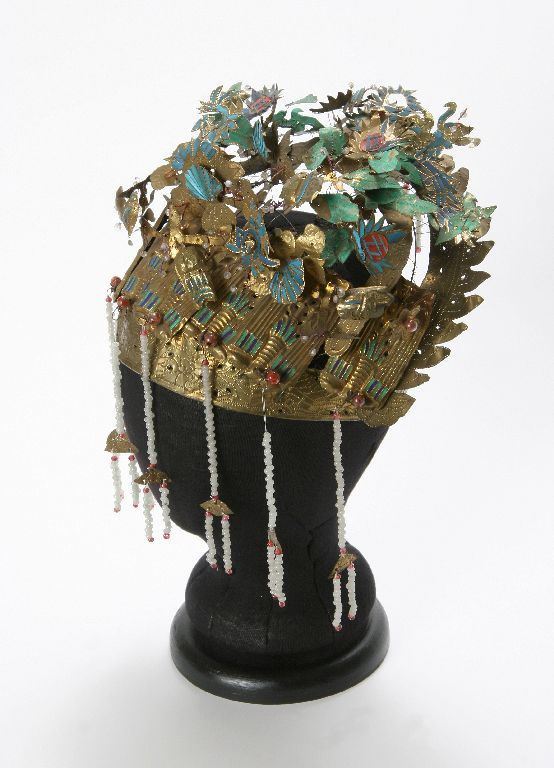
After conservation treatment view of New Brunswick Museum’s Chinese bridal crown.
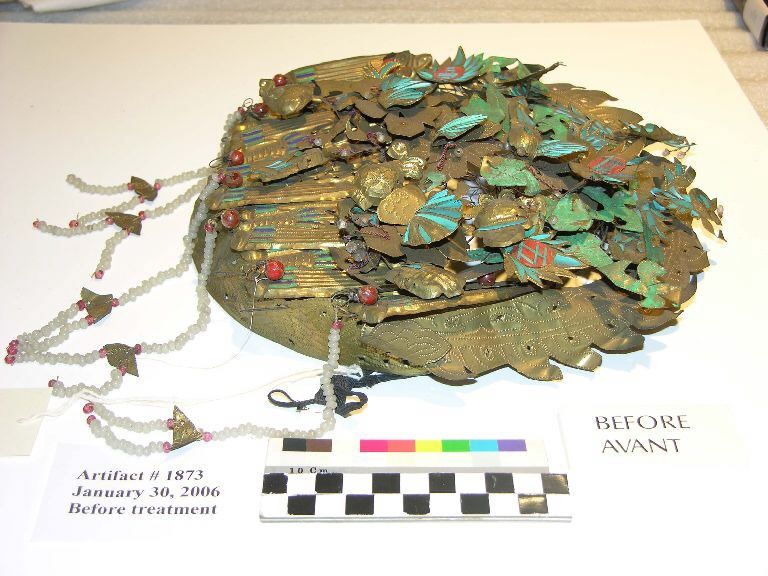
Before conservation treatment view of New Brunswick Museum’s Chinese bridal crown.
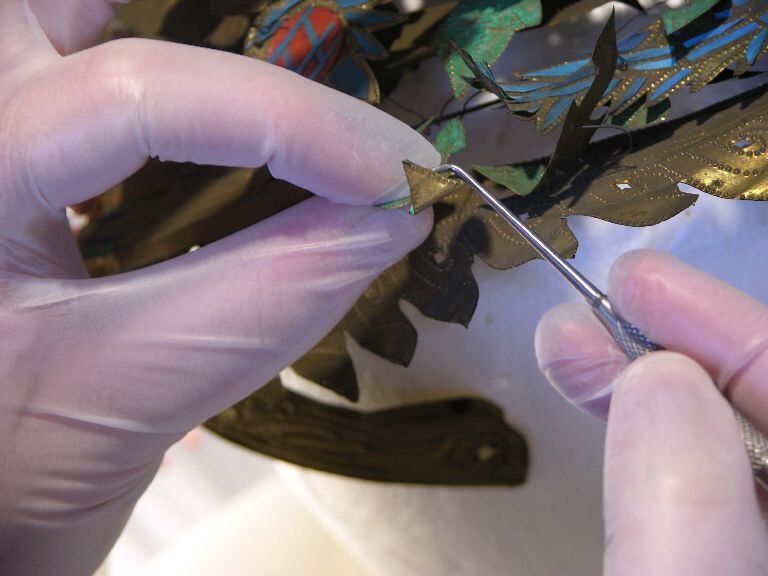
During conservation treatment view of New Brunswick Museum’s Chinese bridal crown.
A: I have worked on many fascinating objects during my 20 years as Conservator at the NBM, so it’s hard to choose a favourite. If I had to pick just one, I would say I most enjoyed working on the wedding crown collected by Saint John medical doctor and missionary Mabel Louise Hanington during her work in Fujian, China in the late nineteenth or early twentieth century and subsequently donated to the New Brunswick Museum (NBM 1873). The artifact was very interesting to me personally and the conservation treatment was challenging and rewarding. I was fortunate to have had the opportunity to present a poster on the treatment at the International Institute for Conservation Congress in Hong Kong in 2014.
Q: What steps do you take to respectfully conserve a very damaged object?
A: Often an object can be very damaged but still be repairable, and if not repairable it may still be invaluable to our research collections. Other times, an object may appear to be in good condition, but may be readily damaged. Regardless of the type or condition of an object, a conservator’s basic approach to all objects remains essentially the same. First, we start with a thorough visual assessment of the object and note our observations of things like the dimensions and description of the object, the materials it is made from, and its current condition, noting any changes from its original condition. Then, after further research, the Conservator will propose a plan for conservation treatment that takes into account the intended use of the object, the extent and type of existing damage and risks of further damage, as well as our capacity to carry out the treatment. We then discuss this proposal with the Curator responsible for that artifact or specimen. (Sometimes, the best course of action is to not proceed with a treatment at all if the risk to the artifact is too great). Once the proposed treatment is agreed on by the various stakeholders, the treatment will be carried out as proposed, and all actions taken and materials used by the conservator are carefully documented. All of this documentation then becomes a permanent part of the museum’s files on that artifact, both in the hard copy documentation files and in our collections management database, which helps us to better care for and understand the object in the future.
Q: I wonder if I don’t have a related major or history background, am I able to join the conservation workforce?
A: While a strong interest in history is common among people who go into the field of conservation, it is not the only route into the profession. A conservator must actually develop knowledge and skills in three very different areas: humanities subjects (such as history, art history, archaeology, anthropology, or architecture), science subjects (especially organic chemistry), and the hand skills that come from experience with fine arts and fine craft.
A list of postsecondary training programs relating to conservation in Canada can be found on the website of the Canadian Association for Conservation of Cultural Property (What is Conservation? – Canadian Association for Conservation of Cultural Property (cac-accr.ca)).
Q: What would be your dream object to work on and why?
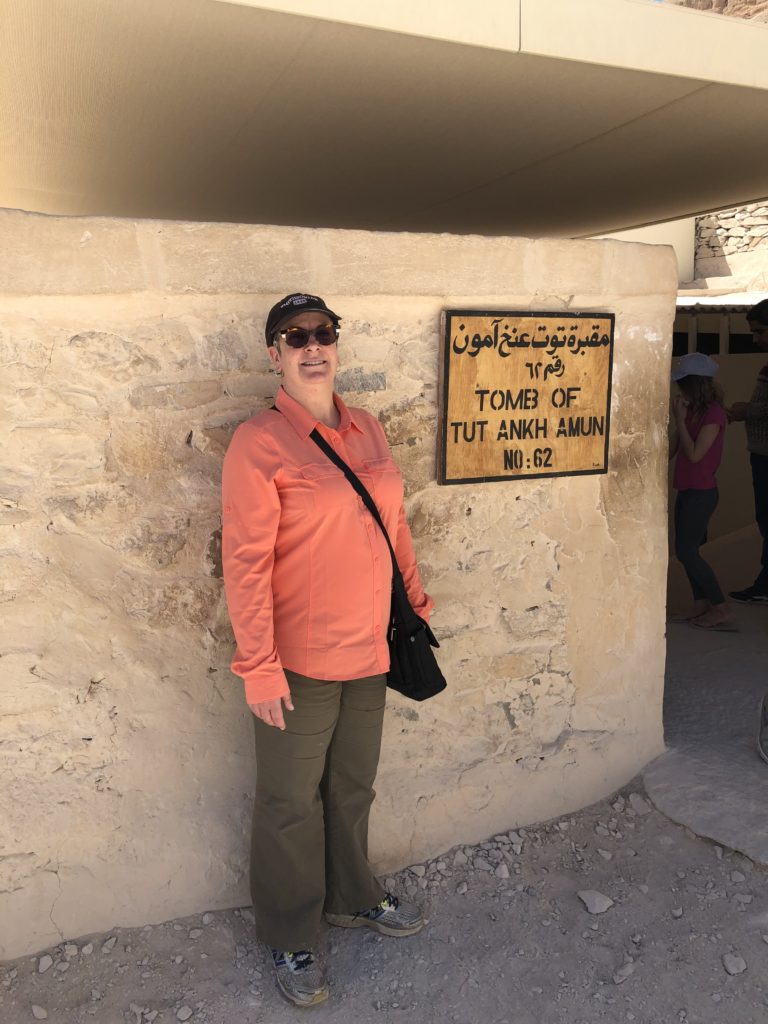
A: I developed a strong interest in archaeology and Egyptology while still a young child in elementary school, so I would have to say any object relating to the tomb of the Pharaoh Tutankhamun would be my absolute dream. I visited the burial site in Luxor and the Egyptian Museum in Cairo (which houses the major artifacts) in 2019 but I have (so far) never gotten my hands on the objects!
Q: I love to frame my children’s artwork, and do my best to avoid hanging them in direct sunlight in my home, however any tips on how to further protect (be proactive) to conserve their artwork for more years to come – for instance laminate, does that help or other suggestions?
A: Kids’ art is typically made with inexpensive media and materials that are not necessarily designed to last a long time. Many of these materials are indeed very easily damaged by exposure to light, so the most effective way to preserve them is to store them in complete darkness. For pieces that you really want to have on display, you can increase the art’s expected longevity by choosing to frame them with archival quality materials and under UV-filtering glass, by choosing a location to hang the art that gets little to no direct sunlight or florescent light (both are high in UV, which is the most damaging component of light), or by limiting the amount of time the art is on display, perhaps rotating the artwork on display with other artworks in storage from time to time so that each piece gets less light exposure over time.
Q: I saw the photo shared with all your tools, what is the one, or couple of tools you use most on a day to day basis?
A: The tools used will vary with the conservation project, however I tend to make a lot of use of precision tools made for the medical field such as surgical needles, surgical scalpels, fine tweezers, dental picks and probes and various kinds of magnifying devices. The single most important tool in my lab is a specialized vacuum cleaner with fine attachments, a very good HEPA filter and suction that can be adjusted very, very low. I use this for my initial “dry” cleaning on almost all objects and specimens.
Q: If there was one or two artifact(s) from any other institution you could access to and offer your hands on expertise what would that be and why?
A: Just a few weeks ago there was a conservation symposium organized around a very special 250 year old silver clockwork swan at the Bowes Museum in the UK. I think it would have been a lot of fun to have had a chance to work with the team of conservators who undertook a major conservation treatment on it. You can see some video footage about that project at Conservation experts take apart and study the Bowes Museum’s 18th century Silver Swan | ITV News Tyne Tees.
Q: Are there programs available to children or youth that have an interest to conservation?
A: Several museums have developed programming or written information about art conservation targeted especially to kids and youth. A good example is this webpage developed by the Metropolitan Museum of Art in New York City. What is Art Conservation.pdf (metmuseum.org).
Q: With the intensive work and effects on your body (hands, fingers, eyes, neck, etc.) are there exercises you do to help with any stress you have? Stretching, yoga, stress ball, etc.?
A: Conservation treatments vary a lot. Depending on the project, there may be risks of repetitive strain injuries, risks from working a heights or working in cramped positions, or from lifting heavy objects. Many treatments involve using solvents and other chemicals that can be hazardous, or the collections themselves may be hazardous such as if they are contaminated by mold or old pesticide residues. All of these risks must be taken into account, and the conservator will try to choose materials, working methods, and personal protective equipment to appropriately manage the risks and protect their health.
Q: What type of projects do you most enjoy working on?
A: Condition assessments and conservation treatments require looking extremely closely at an artifact or specimen. Sometimes that means I get to play detective and can uncover information that has gone unnoticed until then, for example seeing a faintly visible inscription or signature under different kinds of lighting, or correcting a misidentified material through chemical testing or microscopic examination, or understanding how an object has been changed over time, either changes made deliberately or through physical and chemical changes that happen naturally over time. These discoveries are always exciting for me, and the new information then helps us to better understand the significance of an artifact, and informs decision-making about how to best care for the object for long term preservation.
Q: What are you conserving now or what was the last artifact you worked on?
A: Currently I am working on the treatment of a nineteenth century shadow box ship model, as well as a number of non-treatment based preventive conservation projects, including preparing for a major collections move.
Q: How do you develop a conservation plan for a newly acquired object in the NBM collection?
A: An assessment of conservation concerns is part of the process for deciding whether or not to acquire an object for the collection. We need to consider what is required in terms of storage space, environmental controls, and other resources needed to responsibly care for the object over the long term. Sometimes this can be quite complicated if an object is made of inherently unstable materials. Some early forms of plastic, for example, inevitably break down and the off gassing chemical products of that deterioration can actually damage other nearby artifacts and can even be a fire safety issue. There may be human health and safety concerns with many other types of objects. Older taxidermy specimens may have been prepared using arsenic. Other artifacts or specimens might contain mercury or radioactive materials, for example. These preservation issues, health and safety concerns, and the relative curatorial importance of the object all need to be carefully considered before acquisition. Once a decision to acquire an object is made, its care begins with safe transport to the museum, freezing and/or quarantining for pest control, documentation in our collections management databases, a basic cleaning, further conservation work if needed for basic stabilization, and appropriate containerization for long term storage and preservation. This process involves the work of a team of many specialists, including conservators, collections managers, preparators, registrars, and curators.
Q: How can I get the musty smell out of books that were stored in a basement?
We asked this question to our expert, Dee Stubbs-Lee, NBM Conservator.
A: The musty smell is a sign of microbial growth. Basements tend to be high relative humidity environments, and not a great place to store your valuables. First, remove the books to a drier environment with better air circulation. If there are no visible signs of mold other than the odour, place the books in clear plastic bags with sachets of activated charcoal (available from aquarium stores), kitty litter, or baking soda and leave it for several months. I also had good luck experimenting with sachets of zeolites (a volcanic rock product) for a similar issue with a recently collected quilt.

________________________________________________________________________________
Q: How many different kinds of mushrooms occur in New Brunswick? How many are poisonous?
We asked these questions to our expert, Dr. Alfredo Justo, Ph.D., NBM Curator of Botany & Mycology in the Natural History Department.
A: Dr. Alfredo Justo shared with us the following: We do not have a definitive answer yet, but our current best estimate is that we have somewhere between 2500 and 3000 species of mushrooms in New Brunswick. Mycological research is going to be a big focus of the NBM Natural History department in the coming years. The NBM herbarium currently holds approximately 9000 mushroom collections, representing approximately 600 species so we have a long way to go! Most mushrooms are neither edible nor toxic, and roughly 20% of the species can make you sick if eaten. Some, like the destroying angel pictured (Amanita bisporigera) are deadly poisonous.
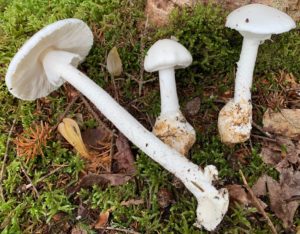
A photo from the NBM Natural History Collections of the destroying angel (Amanita bisporigera) mushrooms which are deadly poisonous.
________________________________________________________________________________
Q: I found this colourful thing growing out of a stump on our property. What is it?
We asked this question to our expert, Dr. Alfredo Justo, Ph.D., NBM Curator of Botany & Mycology in the Natural History Department.
A: Dr. Alfredo Justo shared with us the following: Colorful is the right adjective for this mushroom! – This is the ¨Dyer’s Polypore¨ (Phaeolus schweinitzii). This mushroom gets its common name from one the practical uses that it has: to dye wool that then can be used to make clothes or ornaments. Phaeolus is sought after for the nice brown and yellow pigments that can be used as a natural dye. Ecologically, it also has important roles in nature, acting as a parasite on trees (specially conifers) and then as a wood-decayer, recycling all the dead plant material, and keeping the global carbon cycle functioning properly.
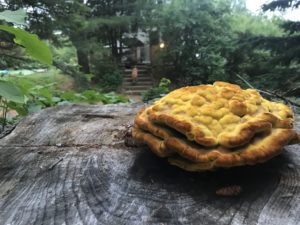
¨Dyer’s Polypore¨ (Phaeolus schweinitzii)
________________________________________________________________________________
Q: Have you ever wondered why fireflies glow? The green blinking of fireflies is a common sight near the fireside across New Brunswick. We asked this question to our expert, Dr. Donald McAlpine, Chair of our Natural History Department and Head of our Zoology Section.
A: Dr. McAlpine shared with us the following:
“Warm, humid, New Brunswick evenings in June and July can turn magical with the flashing of fireflies. There are ten species of fireflies native to NB. Four of them don’t actually “light-up” but the others do, for a variety of reasons. The principal reason is communication – males attracting females and females signalling back. Some species also use their flashing light to attract prey, others to deter predators (apparently, fireflies don’t taste very good). NB firefly larvae feed on terrestrial snails and earthworms, but many adults don’t feed at all. Others take sap, or even specialize in feeding on other species of fireflies, mimicking their flashing pattern to attract male prey.”
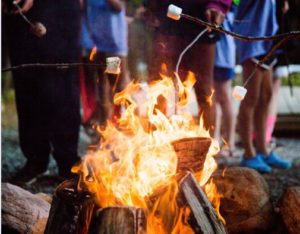
________________________________________________________________________________
Another one of your questions answered by NB Museum experts!
Q : Victoria, age 6 asks … How do leeches stick to you, do they have little razor teeth?
A : Dr. Donald McAlpine, Ph.D., NBM Zoology Curator shares … leeches do indeed have small “razor teeth” referred to as denticles, which occur in three rows. Operating like small saws, the back and forth movement of these “jaws” create a small incision. Suction produced around these jaws permits the leech to remain attached to a host, while an anticoagulant prevents blood from clotting during feeding and digestion. Not all NB leeches (of which there are 20-30 species) feed on blood. Some feed on aquatic molluscs, worms, and even take other leeches. And among those that do feed on blood, several feed mainly on fish or amphibians, and one feeds primarily on the blood of ducks.
An NBM summer student displays a large Haemopis sp leech, a species that feeds on molluscs and worms, rather than blood, during field work in the Nerepis Marsh in the lower Saint John River.
NB hosts a variety of leech species, some of which are prone to feed on those who enter the water in “leech habitat”. In this case NBM Zoology Curator Dr. Donald McAlpine was undertaking field studies on molluscs and dragonflies in the Nerepis Marsh, but was able to add significantly to the NBM leech collection!
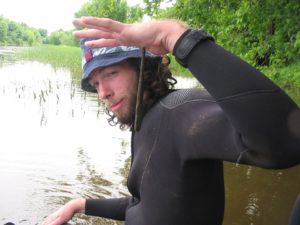
A NBM summer student displays a large Haemopis sp leech, a species that feeds on molluscs and worms, rather than blood, during field work in the Nerepis Marsh in the lower Saint John River.
________________________________________________________________________________
Check out this Q&A:
Q: Jérôme, age 11 asks … I am learning about percentages these days and looking for real life examples, what percentage (approximate) of the paintings in the NBM Art Galleries are hung in their original frames?
A: Peter Larocque, NBM Curator of NB Cultural History & Art shares … Currently have 104 artworks with frames on display in the art galleries. 12 of them are not original frames. Therefore 92 of 104 are original or 88.46 percent of the frames are original to the artworks on display. 12 of the 104 are display frames or 11.53 percent.
In most cases, the NBM attempts to display works in their original frames. Sometimes works are accepted into the collection with no frames, in that case when the work is displayed, a frame that is appropriate for the work and the era it was produced is used. Sometimes works are accepted into the collections and the frames have damage or are considered too unstable for display. If conservation treatment can stabilize and make the frame presentable then it is used. If the frame is too fragile to use, it is removed from work and saved for the information it provides as well as the possible opportunity to have a more extensive conservation treatment done in the future.
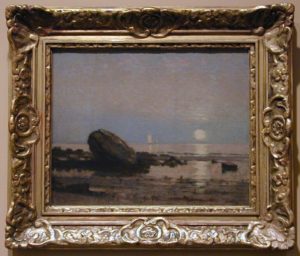
John Hammond (Canadian, 1843 – 1939)
painting: Moonrise, 1907
oil on board
32.9 x 41.7 cm
frame: 51 x 60 cm
Gift of Elizabeth McNally, 1984 (34048)
NBM Collections
This elaborate frame was most likely selected by the artist and was fashionable when the work was created.
________________________________________________________________________________
Q : Lacey, age 8 asks … When walking in my back woods with my family, why do I sometimes see pieces of old wood that turn a pretty green (almost like dye or food coloring) like in this photo?
A : Dr. Alfredo Justo, Ph.D., NBM Curator of Botany & Mycology shares … the green color in the wood is caused by the fungus Chlorociboria aeruginascens, also known as “green stain fungus”, “green elf cup” or “green wood cup”. The fungus grows by decomposing fallen branches and logs in the forest, and in the process gives them the characteristic green color. This is an example of the very important ecological role that fungi have in forest ecosystems, continuously recycling all the plant material. During mushroom season this fungus will produce mushrooms in the form of small, bright green cups. Also, here is a photo from the NBM Natural History Collections of a wasp nest in which the wasps used some green stained wood in nest construction.
Other useful links with additional information include:
https://www.mushroomexpert.com/chlorociboria_aeruginascens.…
https://botit.botany.wisc.edu/toms_fungi/jul2008.html
https://en.wikipedia.org/wiki/Chlorociboria_aeruginascens
https://www.mycoquebec.org/bas.php…
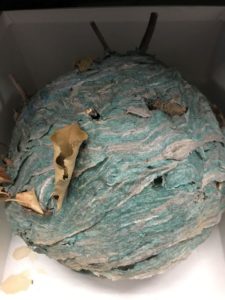
A photo from the NBM Natural History Collections of a wasp nest in which the wasps used some green stained wood in nest construction.
